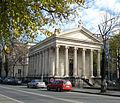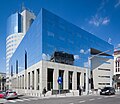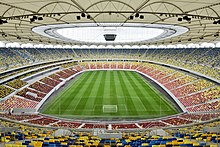Bucharest, Romania
Bucharest was first mentioned in documents in 1459. The city became the capital in 1862 and is the centre of Romanian media, culture, and art. Its architecture is a mix of historical (mostly Eclectic, but also Neoclassical and Art Nouveau), interbellum (Bauhaus, Art Deco, and Romanian Revival architecture), socialist era, and modern. In the period between the two World Wars, the city's elegant architecture and the sophistication of its elite earned Bucharest the nicknames of Little Paris or Paris of the East. Although buildings and districts in the historic city centre were heavily damaged or destroyed by war, earthquakes, and even Nicolae Ceaușescu's program of systematization, many survived and have been renovated. In recent years, the city has been experiencing an economic and cultural boom. It is one of the fastest-growing high-tech cities in Europe. In 2016, the historical city centre was listed as 'endangered' by the World Monuments Watch.
In January 2023, there were 1.74 million inhabitants living within the city limits, and adding the satellite towns around the urban area, the proposed metropolitan area of Bucharest would have a population of 2.3 million people. In 2020, the government used 2.5 million people as the basis for pandemic reports. Bucharest is the eighth largest city in the European Union by population within city limits. In 2017, Bucharest was the European city with the highest growth of tourists who stay over night, according to the Mastercard Global Index of Urban Destinations. As for the past two consecutive years, 2018 and 2019, Bucharest ranked as the European destination with the highest potential for development according to the same study.
Economically, Bucharest is the most prosperous city in Romania and the richest capital and city in the region, having surpassed Budapest since 2017. The city has a number of large convention facilities, educational institutes, cultural venues, traditional 'shopping arcades' and recreational areas. The city proper is administratively known as the 'Municipality of Bucharest' (Romanian: Municipiul București), and has the same administrative level as that of a national county, being further subdivided into six sectors, each governed by a local mayor.
Etymology
The Romanian name București has an unverified origin. Tradition connects the founding of Bucharest with the name of Bucur, who was a prince, an outlaw, a fisherman, a shepherd or a hunter, according to different legends. In Romanian, the word stem bucurie means 'joy' ('happiness'), hence the city Bucharest means 'city of joy'.
Other etymologies are given by early scholars, including the one of an Ottoman traveller, Evliya Çelebi, who claimed that Bucharest was named after a certain 'Abu-Kariș', from the tribe of 'Bani-Kureiș'. In 1781, Austrian historian Franz Sulzer claimed that it was related to bucurie (joy), bucuros (joyful), or a se bucura (to be joyful), while an early 19th-century book published in Vienna assumed its name to be derived from 'Bukovie', a beech forest. In English, the city's name was formerly rendered as Bukarest. A native or resident of Bucharest is called a 'Bucharester' (Romanian: bucureștean).
History


Bucharest's history alternated periods of development and decline from the early settlements in antiquity until its consolidation as the national capital of Romania late in the 19th century. First mentioned as the 'Citadel of București' in 1459, it became the residence of the ruler of Wallachia, Voivode Vlad the Impaler.
The Old Princely Court (Curtea Veche) was erected by Mircea Ciobanul in the mid-16th century. Under subsequent rulers, Bucharest was established as the summer residence of the royal court. During the years to come, it competed with Târgoviște on the status of capital city after an increase in the importance of Southern Muntenia brought about by the demands of the suzerain power – the Ottoman Empire.
Bucharest finally became the permanent location of the Wallachian court after 1698 (starting with the reign of Constantin Brâncoveanu). The city was partly destroyed by natural disasters and rebuilt several times during the following 200 years.
The Ottomans appointed Greek administrators (Phanariotes) to run the town (Ottoman Turkish: بكرش, romanized: Bukreş) from the 18th century. The 1821 Wallachian uprising initiated by Tudor Vladimirescu led to the end of the rule of Constantinople Greeks in Bucharest.
In 1813–14 the city was hit by Caragea's plague. The city was wrested from Ottoman influence and occupied at several intervals by the Habsburg monarchy (1716, 1737, 1789) and Imperial Russia (three times between 1768 and 1806). It was placed under Russian administration between 1828 and the Crimean War, with an interlude during the Bucharest-centred 1848 Wallachian revolution. Later, an Austrian garrison took possession after the Russian departure (remaining in the city until March 1857). On 23 March 1847, a fire consumed about 2,000 buildings, destroying a third of the city.
In 1862, after Wallachia and Moldavia were united to form the Principality of Romania, Bucharest became the new nation's capital city. In 1881, it became the political centre of the newly proclaimed Kingdom of Romania under King Carol I. During the second half of the 19th century, the city's population increased dramatically, and a new period of urban development began. During this period, gas lighting, horse-drawn trams, and limited electrification were introduced. The Dâmbovița River was also massively channelled in 1883, thus putting a stop to previously endemic floods like the 1865 flooding of Bucharest. The Fortifications of Bucharest were built. The extravagant architecture and cosmopolitan high culture of this period won Bucharest the nickname of 'Paris of the East' (Parisul Estului), with the Calea Victoriei as its Champs-Élysées.
Between 6 December 1916 and November 1918, the city was occupied by German forces as a result of the Battle of Bucharest, with the official capital temporarily moved to Iași (also called Jassy), in the Moldavia region. After World War I, Bucharest became the capital of Greater Romania. In the interwar years, Bucharest's urban development continued, with the city gaining an average of 30,000 new residents each year. Also, some of the city's main landmarks were built in this period, including Arcul de Triumf and Palatul Telefoanelor. However, the Great Depression in Romania took its toll on Bucharest's citizens, culminating in the Grivița Strike of 1933.
In January 1941, the city was the scene of the Legionnaires' rebellion and Bucharest pogrom. As the capital of an Axis country and a major transit point for Axis troops en route to the Eastern Front, Bucharest suffered heavy damage during World War II due to Allied bombings. On 23 August 1944, Bucharest was the site of the royal coup which brought Romania into the Allied camp. The city suffered a short period of Nazi Luftwaffe bombings, as well as a failed attempt by German troops to regain the city.

After the establishment of communism in Romania, the city continued growing. New districts were constructed, most of them dominated by tower blocks. During Nicolae Ceaușescu's leadership (1965–89), a part of the historic city was demolished and replaced by 'Socialist realism' style development: (1) the Centrul Civic (the Civic Centre) and (2) the Palace of the Parliament, for which an entire historic quarter was razed to make way for Ceaușescu's megalomaniac plans. On 4 March 1977, an earthquake centred in Vrancea, about 135 km (83.89 mi) away, claimed 1,500 lives and caused further damage to the historic centre.
The Romanian Revolution of 1989 began with massive anti-Ceaușescu protests in Timișoara in December 1989 and continued in Bucharest, leading to the overthrow of the Communist regime. Dissatisfied with the postrevolutionary leadership of the National Salvation Front, some student leagues and opposition groups organised anti-Communist rallies in early 1990, which caused the political change.
Since 2000, the city has been continuously modernised. Residential and commercial developments are underway, particularly in the northern districts; Bucharest's old historic centre has undergone restoration since the mid-2000s.
In 2015, 64 people were killed in the Colectiv nightclub fire. Later the Romanian capital saw the 2017–2019 Romanian protests against the judicial reforms, with a 2018 protest ending with 450 people injured.
Treaties
The following treaties were signed in the city:
- Treaty of Bucharest (1812), between the Ottoman Empire and the Russian Empire ending the Russo-Turkish War (1806–1812)
- Treaty of Bucharest (1886), between Serbia and Bulgaria ending the Serbian–Bulgarian War
- Treaty of Bucharest (1913), between Bulgaria, Romania, Serbia, Montenegro and Greece ending of the Second Balkan War
- Treaty of Bucharest (1916), a treaty of alliance between Romania and the Entente Powers
- Treaty of Bucharest (1918), between Romania and the Central Powers
Geography
General
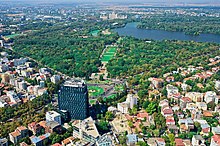
The city is situated on the banks of the Dâmbovița River, which flows into the Argeș River, a tributary of the Danube. Several lakes – the most important of which are Lake Herăstrău, Lake Floreasca, Lake Tei, and Lake Colentina – stretch across the northern parts of the city, along the Colentina River, a tributary of the Dâmbovița. In addition, in the centre of the capital is a small artificial lake – Lake Cișmigiu – surrounded by the Cișmigiu Gardens. These gardens have a rich history, having been frequented by poets and writers. Opened in 1847 and based on the plans of German architect Carl F.W. Meyer, the gardens are the main recreational facility in the city centre.

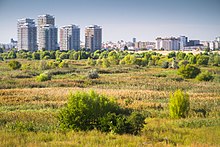

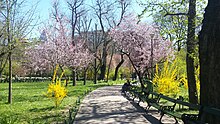
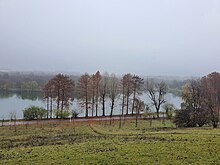

Bucharest parks and gardens also include Herăstrău Park, Tineretului Park and the Botanical Garden. Herăstrău Park is located in the northern part of the city, around Lake Herăstrău, and includes the site the Village Museum. Grigore Antipa Museum is also near in the Victoriei Square. One of its best known locations are Hard Rock Cafe Bucharest and Berăria H (one of the largest beer halls in Europe). Tineretului Park was created in 1965 and designed as the main recreational space for southern Bucharest. It contains a Mini Town which is a play area for kids. The Botanical Garden, located in the Cotroceni neighbourhood a bit west of the city centre, is the largest of its kind in Romania and contains over 10,000 species of plants (many of them exotic); it originated as the pleasure park of the royal family. Besides them, there are many other smaller parks that should be visited, some of them being still large. Alexandru Ioan Cuza Park, Kiseleff Park, Carol Park, Izvor Park, Grădina Icoanei, Circului Park and Moghioroș Park are a few of them. Other large parks in Bucharest are: National Park, Tei Park, Eroilor Park and Crângași Park with Morii Lake.
Lake Văcărești is located in the southern part of the city. Over 190 hectares, including 90 hectares of water, host 97 species of birds, half of them protected by law, and at least seven species of mammals. The lake is surrounded by buildings of flats and is an odd result of human intervention and nature taking its course. The area was a small village that Ceaușescu attempted to convert into a lake. After demolishing the houses and building the concrete basin, the plan was abandoned following the 1989 revolution. For nearly two decades, the area shifted from being an abandoned green space where children could play and sunbathe, to being contested by previous owners of the land there, to being closed for redevelopment into a sports centre. The redevelopment deal failed, and over the following years, the green space grew into a unique habitat. In May 2016, the lake was declared a national park, the Văcărești Nature Park. Dubbed the 'Delta of Bucharest', the area is protected.
Bucharest is situated in the center of the Romanian Plain, in an area once covered by the Vlăsiei Forest, which after it was cleared, gave way for a fertile flatland. As with many cities, Bucharest is traditionally considered to be built upon seven hills, similar to the seven hills of Rome. Bucharest's seven hills are: Mihai Vodă, Dealul Mitropoliei, Radu Vodă, Cotroceni, Dealul Spirii, Văcărești, and Sfântu Gheorghe Nou.
The city has an area of 226 km (87 sq mi). The altitude varies from 55.8 m (183.1 ft) at the Dâmbovița bridge in Cățelu, southeastern Bucharest and 91.5 m (300.2 ft) at the Militari church. The city has a roughly round shape, with the centre situated in the cross-way of the main north–south/east-west axes at University Square. The milestone for Romania's Kilometre Zero is placed just south of University Square in front of the New St. George Church (Sfântul Gheorghe Nou) at St. George Square (Piața Sfântul Gheorghe). Bucharest's radius, from University Square to the city limits in all directions, varies from 10 to 12 km (6 to 7 mi).
Until recently, the regions surrounding Bucharest were largely rural, but after 1989, suburbs started to be built around Bucharest, in the surrounding Ilfov County. This county, which has experienced rapid demographic growth in the 21st century, being the fastest growing Romanian county between 2011 and 2021, had a population of 542,686 people at the 2021 Romanian census. In the 21st century, many of Ilfov county's villages and communes developed into high-income commuter towns, which act like suburbs or satellites of Bucharest.
Climate
Bucharest has a humid continental climate (Dfa by the 0 °C isotherm), or a humid subtropical climate (Köppen: Cfa by the -3 °C isotherm), with hot, humid summers and cold, snowy winters. Owing to its position on the Romanian Plain, the city's winters can get windy, though some of the winds are mitigated due to urbanisation. Winter temperatures often dip below 0 °C (32 °F), sometimes even to −10 °C (14 °F). In summer, the average high temperature is 29.8 °C (85.6 °F) (the average for July and August). Temperatures frequently reach 35 to 40 °C (95 to 104 °F) in midsummer in the city centre. Although average precipitation in summer is moderate, occasional heavy storms occur. During spring and autumn, daytime temperatures vary between 17 and 22 °C (63 and 72 °F), and precipitation during spring tends to be higher than in summer, with more frequent yet milder periods of rain.
| Climate data for Bucharest Băneasa (1991–2020 normals, extremes 1929–present) | |||||||||||||
|---|---|---|---|---|---|---|---|---|---|---|---|---|---|
| Month | Jan | Feb | Mar | Apr | May | Jun | Jul | Aug | Sep | Oct | Nov | Dec | Year |
| Record high °C (°F) | 20.9 (69.6) |
24.1 (75.4) |
29.0 (84.2) |
32.2 (90.0) |
36.9 (98.4) |
39.0 (102.2) |
42.6 (108.7) |
41.0 (105.8) |
38.5 (101.3) |
35.2 (95.4) |
25.1 (77.2) |
18.4 (65.1) |
42.6 (108.7) |
| Mean daily maximum °C (°F) | 3.0 (37.4) |
6.3 (43.3) |
12.3 (54.1) |
18.5 (65.3) |
24.1 (75.4) |
28.1 (82.6) |
30.4 (86.7) |
30.6 (87.1) |
25.0 (77.0) |
18.0 (64.4) |
10.5 (50.9) |
4.2 (39.6) |
17.6 (63.7) |
| Daily mean °C (°F) | −1.5 (29.3) |
0.6 (33.1) |
5.6 (42.1) |
11.4 (52.5) |
16.8 (62.2) |
21.1 (70.0) |
23.0 (73.4) |
22.4 (72.3) |
16.8 (62.2) |
10.7 (51.3) |
5.3 (41.5) |
0.0 (32.0) |
11.0 (51.8) |
| Mean daily minimum °C (°F) | −5.0 (23.0) |
−3.5 (25.7) |
0.3 (32.5) |
4.9 (40.8) |
9.7 (49.5) |
13.9 (57.0) |
15.6 (60.1) |
15.2 (59.4) |
10.7 (51.3) |
5.7 (42.3) |
1.4 (34.5) |
−3.3 (26.1) |
5.5 (41.9) |
| Record low °C (°F) | −32.2 (−26.0) |
−29.0 (−20.2) |
−21.7 (−7.1) |
−9.5 (14.9) |
−5.0 (23.0) |
4.5 (40.1) |
7.4 (45.3) |
5.2 (41.4) |
−3.1 (26.4) |
−8.0 (17.6) |
−19.4 (−2.9) |
−25.6 (−14.1) |
−32.2 (−26.0) |
| Average precipitation mm (inches) | 40.1 (1.58) |
33.0 (1.30) |
42.4 (1.67) |
50.2 (1.98) |
70.4 (2.77) |
82.7 (3.26) |
68.6 (2.70) |
48.9 (1.93) |
60.5 (2.38) |
60.7 (2.39) |
43.6 (1.72) |
47.0 (1.85) |
648.1 (25.52) |
| Average snowfall cm (inches) | 13.7 (5.4) |
11.0 (4.3) |
10.5 (4.1) |
1.5 (0.6) |
0.0 (0.0) |
0.0 (0.0) |
0.0 (0.0) |
0.0 (0.0) |
0.0 (0.0) |
0.0 (0.0) |
8.8 (3.5) |
10.5 (4.1) |
56.0 (22.0) |
| Average precipitation days (≥ 1.0 mm) | 6.1 | 5.4 | 6.3 | 6.2 | 8.4 | 8.3 | 7.1 | 5.2 | 4.9 | 5.6 | 5.4 | 6.7 | 75.6 |
| Average relative humidity (%) | 86 | 82 | 71 | 63 | 62 | 61 | 58 | 57 | 61 | 73 | 84 | 87 | 70 |
| Average dew point °C (°F) | −4.2 (24.4) |
−2.7 (27.1) |
0.9 (33.6) |
5.4 (41.7) |
10.2 (50.4) |
13.9 (57.0) |
15.3 (59.5) |
14.7 (58.5) |
11.6 (52.9) |
6.8 (44.2) |
2.5 (36.5) |
−1.3 (29.7) |
6.1 (43.0) |
| Mean monthly sunshine hours | 78.8 | 107.1 | 156.7 | 195.3 | 245.4 | 259.4 | 293.4 | 283.0 | 208.7 | 149.6 | 84.8 | 63.9 | 2,126.1 |
| Average ultraviolet index | 1 | 2 | 3 | 5 | 7 | 8 | 8 | 7 | 5 | 3 | 2 | 1 | 4 |
| Source 1: NOAA (dew point and snowfall 1961–1990) | |||||||||||||
| Source 2: Administrația Națională de Meteorologie (extremes), Danish Meteorological Institute (humidity, 1931–1960) and Weather Atlas | |||||||||||||
Government
Administration
Bucharest has a unique status in Romanian administration, since it is the only municipal area that is not part of a county. Its population, however, is larger than that of any other Romanian county, hence the power of the Bucharest General Municipality (Primăria Generală), which is the capital's local government body, is the same as any other Romanian county council.
The Municipality of Bucharest, along with the surrounding Ilfov County, is part of the București – Ilfov development region project, which is equivalent to NUTS-II regions in the European Union and is used both by the EU and the Romanian government for statistical analysis, and to co-ordinate regional development projects and manage funds from the EU. The Bucharest-Ilfov development region is not, however, an administrative entity yet.

The city government is headed by a general mayor (Primar General). Since 29 October 2020 onwards, it is Nicușor Dan, currently an independent politician previously backed by the PNL-USR PLUS centre-right alliance at the 2020 Romanian local elections. Decisions are approved and discussed by the capital's General Council (Consiliu General) made up of 55 elected councilors. Furthermore, the city is divided into six administrative sectors (sectoare), each of which has its own 27-seat sectoral council, town hall, and mayor. The powers of the local government over a certain area are, therefore, shared both by the Bucharest municipality and the local sectoral councils with little or no overlapping of authority. The general rule is that the main capital municipality is responsible for citywide utilities such as the water and sewage system, the overall transport system, and the main boulevards, while sectoral town halls manage the contact between individuals and the local government, secondary streets and parks maintenance, schools administration, and cleaning services.
The six sectors are numbered from one to six and are disposed radially so that each one has under its administration a certain area of the city centre. They are numbered clockwise and are further divided into sectoral quarters (cartiere) which are not part of the official administrative division:
- Sector 1 (population 227,717): Dorobanți, Băneasa, Aviației, Pipera, Aviatorilor, Primăverii, Romană, Victoriei, Herăstrău Park, Bucureștii Noi, Dămăroaia, Străulești, Grivița, 1 Mai, Băneasa Forest, Pajura, Domenii, Chibrit
- Sector 2 (population 357,338): Pantelimon, Colentina, Iancului, Tei, Floreasca, Moșilor, Obor, Vatra Luminoasă, Fundeni, Plumbuita, Ștefan cel Mare, Baicului
- Sector 3 (population 399,231): Vitan, Dudești, Titan, Centrul Civic, Dristor, Lipscani, Muncii, Unirii
- Sector 4 (population 300,331): Berceni, Olteniței, Giurgiului, Progresul, Văcărești, Timpuri Noi, Tineretului
- Sector 5 (population 288,690): Rahova, Ferentari, Giurgiului, Cotroceni, 13 Septembrie, Dealul Spirii
- Sector 6 (population 371,060): Giulești, Crângași, Drumul Taberei, Militari, Grozăvești (also known as Regie), Ghencea

Each sector is governed by a local mayor, as follows: Sector 1 – Clotilde Armand (USR, since 2020), Sector 2 – Radu Mihaiu (USR, since 2020), Sector 3 – Robert Negoiță (PRO B, since 2012), Sector 4 – Daniel Băluță (PSD, since 2016), Sector 5 – Vlad Popescu Piedone (former mayor Cristian Popescu Piedone's son) (PUSL, since 2024), Sector 6 – Ciprian Ciucu (PNL, since 2020).
Like all other local councils in Romania, the Bucharest sectoral councils, the capital's general council, and the mayors are elected every four years by the population. Additionally, Bucharest has a prefect, who is appointed by Romania's national government. The prefect is not allowed to be a member of a political party and his role is to represent the national government at the municipal level. The prefect is acting as a liaison official facilitating the implementation of national development plans and governing programs at local level. The prefect of Bucharest (as of 2024) is Mihai Mugur Toader.
City general council
The city's general council has the following political composition, based on the results of the 2024 local elections:
| Party | Seats | Current Council | ||||||||||||||||||||||||
|---|---|---|---|---|---|---|---|---|---|---|---|---|---|---|---|---|---|---|---|---|---|---|---|---|---|---|
| USR + PMP + FD (ADU) | 17 | |||||||||||||||||||||||||
| Social Democratic Party (PSD) | 16 | |||||||||||||||||||||||||
| National Liberal Party (PNL) | 7 | |||||||||||||||||||||||||
| Social Liberal Humanist Party (PUSL) | 6 | |||||||||||||||||||||||||
| Alliance for the Union of Romania (AUR) | 5 | |||||||||||||||||||||||||
| Renewing Romania's European Project (REPER) | 4 | |||||||||||||||||||||||||
Justice system
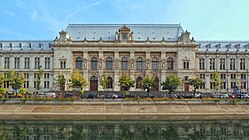
Bucharest's judicial system is similar to that of the Romanian counties. Each of the six sectors has its own local first-instance court (judecătorie), while more serious cases are directed to the Bucharest Tribunal (Tribunalul Bucureşti), the city's municipal court. The Bucharest Court of Appeal (Curtea de Apel Bucureşti) judges appeals against decisions taken by first-instance courts and tribunals in Bucharest and in five surrounding counties (Teleorman, Ialomița, Giurgiu, Călărași, and Ilfov). Bucharest is also home to Romania's supreme court, the High Court of Cassation and Justice, as well as to the Constitutional Court of Romania.
Bucharest has a municipal police force, the Bucharest Police (Poliția București), which is responsible for policing crime within the whole city, and operates a number of divisions. The Bucharest Police are headquartered on Ștefan cel Mare Blvd. in the city centre, and at precincts throughout the city. From 2004 onwards, each sector city hall also has under its administration a community police force (Poliția Comunitară), dealing with local community issues. Bucharest also houses the general inspectorates of the Gendarmerie and the national police.
Crime


Bucharest's crime rate is rather low in comparison to other European capital cities, with the number of total offences declining by 51% between 2000 and 2004, and by 7% between 2012 and 2013. Bucharest, along with Cluj-Napoca, Timișoara, Brașov and Iași, was ranked among the top 100 safest cities in the world in a list compiled by Numbeo. The study found Bucharest to be very safe with regard to aspects such walking alone, home invasions, muggings, cars being stolen, assault, insults, assault due to skin color, ethnic origin, or gender, drug dealing, and armed robberies, with the only crimes in the high category being corruption and bribery. In 2015, the homicide rate of Bucharest was 0,8 per 100,000 people.
Crime in Bucharest is combated by national forces, such as the Romanian Police and Romanian Gendarmerie, and by local forces, such as the Local Police of Bucharest.

Although in the 2000s, a number of police crackdowns on organised crime gangs occurred, such as the Cămătaru clan, organised crime generally has little impact on public life. Petty crime, however, is more common, particularly in the form of pickpocketing, which occurs mainly on the city's public transport network. Confidence tricks were common in the 1990s, especially in regards to tourists, but the frequency of these incidents has since declined. Theft was reduced by 13.6% in 2013 compared to 2012. Levels of crime are higher in the southern districts of the city, particularly in Ferentari, a socially disadvantaged area.
Although the presence of street children was a problem in Bucharest in the 1990s, their numbers have declined in recent years, now lying at or below the average of major European capital cities.
Quality of life
As stated by the Mercer international surveys for quality of life in cities around the world, Bucharest occupied the 94th place in 2001 and slipped lower, to the 108th place in 2009 and the 107th place in 2010. Compared to it, Vienna occupied number one worldwide in 2011 and 2009. Warsaw ranked 84th, Istanbul 112th, and neighbours Sofia 114th and Belgrade 136th (in the 2010 rankings).
Mercer Human Resource Consulting issues yearly a global ranking of the world's most livable cities based on 39 key quality-of-life issues. Among them: political stability, currency-exchange regulations, political and media censorship, school quality, housing, the environment, and public safety. Mercer collects data worldwide, in 215 cities. The difficult situation of the quality of life in Bucharest is confirmed also by a vast urbanism study, done by the Ion Mincu University of Architecture and Urbanism.
In 2016, Bucharest's urban situation was described as 'critical' by a Romanian Order of Architects (OAR) report that criticised the city's weak, incoherent and arbitrary public management policies, its elected officials' lack of transparency and public engagement, as well as its inadequate and unsustainable use of essential urban resources. Bucharest's historical city centre is listed as 'endangered' by the World Monuments Watch (as of 2016).
Although many neighbourhoods, particularly in the southern part of the city, lack sufficient green space, being formed of cramped, high-density blocks of flats, Bucharest also has many parks.
In 2024, Bucharest was ranked by the digital publication Freaking Nomads as the 9th best city in the world for digital nomads, due to its elaborate and diverse architecture, an arts scene featuring some of the world’s best galleries, museums, and theatres, and its tranquil parks.
Demographics
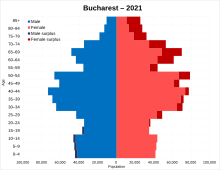
| Year | Pop. | ±% |
|---|---|---|
| 1595 | 10,000 | — |
| 1650 | 20,000 | +100.0% |
| 1789 | 30,030 | +50.2% |
| 1831 | 60,587 | +101.8% |
| 1851 | 60,000 | −1.0% |
| 1859 | 121,734 | +102.9% |
| 1877 | 177,646 | +45.9% |
| 1900 | 282,071 | +58.8% |
| 1912 | 341,321 | +21.0% |
| 1930 | 639,040 | +87.2% |
| 1941 | 992,536 | +55.3% |
| 1948 | 1,041,807 | +5.0% |
| 1956 | 1,177,661 | +13.0% |
| 1966 | 1,366,684 | +16.1% |
| 1972 | 1,511,239 | +10.6% |
| 1977 | 1,807,239 | +19.6% |
| 1982 | 1,898,323 | +5.0% |
| 1987 | 1,985,393 | +4.6% |
| 1992 | 2,064,474 | +4.0% |
| 2002 | 1,926,334 | −6.7% |
| 2011 | 1,883,425 | −2.2% |
| 2021 | 1,716,961 | −8.8% |
| 1851 data: Chambers's Encyclopaedia, 1900: Encyclopædia Britannica, 1941, 1948, other data: Population size may be affected by changes in administrative divisions. | ||
As per the 2021 census, 1,716,961 inhabitants lived within the city limits, a decrease from the figure recorded at the 2011 census. This decrease is due to low natural increase, but also to a shift in population from the city itself to its smaller satellite towns such as Popești-Leordeni, Voluntari, Chiajna, Bragadiru, Pantelimon, Buftea and Otopeni. In a study published by the United Nations, Bucharest placed 19th among 28 cities that recorded sharp declines in population from 1990 to the mid-2010s. In particular, the population fell by 3.77%.
The city's population, according to the 2002 census, was 1,926,334 inhabitants, or 8.9% of the total population of Romania. A significant number of people commute to the city every day, mostly from the surrounding Ilfov County, but official statistics regarding their numbers do not exist.
Bucharest's population experienced two phases of rapid growth, the first beginning in the late 19th century when the city was consolidated as the national capital and lasting until the Second World War, and the second during the Ceaușescu years (1965–1989), when a massive urbanization campaign was launched and many people migrated from rural areas to the capital. At this time, due to Ceaușescu's decision to ban abortion and contraception, natural increase was also significant.
Bucharest is a city of high population density: 8,260/km (21,400/sq mi), as most of the population lives in high-density communist era apartment blocks (blocuri). However, this also depends on the part of the city: the southern boroughs have a higher density than the northern ones. Of the European Union country capital-cities, only Paris and Athens have a higher population density (see List of European Union cities proper by population density). In addition to blocks of flats built during the communist era, there are also older interwar ones, as well as newer ones built in the 1990s and in the 21st century. Although apartment buildings are strongly associated with the communist era, such housing schemes were first introduced in Bucharest in the 1920s.
About 97.3% of the population of Bucharest for whom data are available is Romanian. Other significant ethnic groups are Romani, Hungarians, Turks, Jews, Germans (mostly Regat Germans), Chinese, Russians, Ukrainians, and Italians. A relatively small number of Bucharesters are also Greeks, Armenians, Kurds, Bulgarians, Albanians, Poles, French, Arabs, Africans (including the Afro-Romanians), Iranians, Vietnamese, Filipinos, Nepalis, Afghans, Sri Lankans, Bangladeshis, Pakistanis, and Indians. 226,943 people did not declare their ethnicity.
In terms of religious affiliation, 96.1% of the population for whom data are available is Romanian Orthodox, 1.2% is Roman Catholic, 0.5% is Muslim, and 0.4% is Romanian Greek Catholic. Despite this, only 18% of the population, of any religion, attends a place of worship once a week or more. The life expectancy of residents of Bucharest in 2015 was 77.8 years old, which is 2.4 years above the national average.
Economy
Bucharest is the centre of the Romanian economy and industry, accounting for around 24% (2017) of the country's GDP and about one-quarter of its industrial production, while being inhabited by 9% of the country's population. Almost one-third of national taxes is paid by Bucharest's citizens and companies. The living standard in the Bucharest–Ilfov region was 145% of the EU average in 2017, according to GDP per capita at the purchasing power parity standard (adjusted to the national price level).
The Bucharest area surpassed, on comparable terms, European metropolitan areas such as Budapest (139%), Madrid (125%), Berlin (118%), Rome (110%), Lisbon (102%), and Sofia (79%), and more than twice the Romanian average. After relative stagnation in the 1990s, the city's strong economic growth has revitalised infrastructure and led to the development of shopping malls, residential estates, and high-rise office buildings. In January 2013, Bucharest had an unemployment rate of 2.1%, significantly lower than the national unemployment rate of 5.8%.

Bucharest's economy is centred on industry and services, with services particularly growing in importance in the past 10 years. The headquarters of 186,000 firms, including nearly all large Romanian companies, are located in Bucharest. An important source of growth since 2000 has been the city's rapidly expanding property and construction sector. Bucharest is also Romania's largest centre for information technology and communications and is home to several software companies operating offshore delivery centres. Romania's largest stock exchange, the Bucharest Stock Exchange, which was merged in December 2005 with the Bucharest-based electronic stock exchange Rasdaq, plays a major role in the city's economy.
Malls and large shopping centres have been built since the late 1990s, such as Băneasa Shopping City, AFI Palace Cotroceni, Mega Mall, București Mall, ParkLake Shopping Centre, Sun Plaza, Promenada Mall and longest Unirea Shopping Centre. Bucharest has over 20 malls as of 2019.
The corporations Amazon, Microsoft, Ubisoft, Oracle Corporation, or IBM are all present in the Romanian capital. The top ten is also dominated by companies operating in automotive, oil & gas (such as Petrom), as well as companies in telecommunication and FMCG. The Speedtest Global Index ranks Bucharest the 6th city in the world (after Beijing, Shanghai, Abu Dhabi, Valparaíso, and Lyon) in terms of fixed broadband speed, at 250Mbps as of 2023.
-
IBM Bucharest
-
Floreasca City Center (including SkyTower and Oracle headquarters)
-
Amazon operates office space in the Globalworth Tower.
-
Petrom City
Transport

Bucharest is crossed by two major international routes: Pan-European transport corridor IV and IX.
Public transport
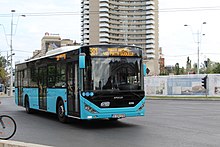






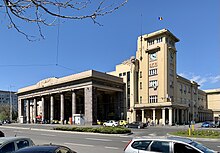
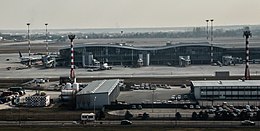









![With a price tag of $250 million, Floreasca City Center opened in 2012.[110]](http://upload.wikimedia.org/wikipedia/en/thumb/b/b1/Sky_Tower_Bucharest_-_panoramio.jpg/90px-Sky_Tower_Bucharest_-_panoramio.jpg)













